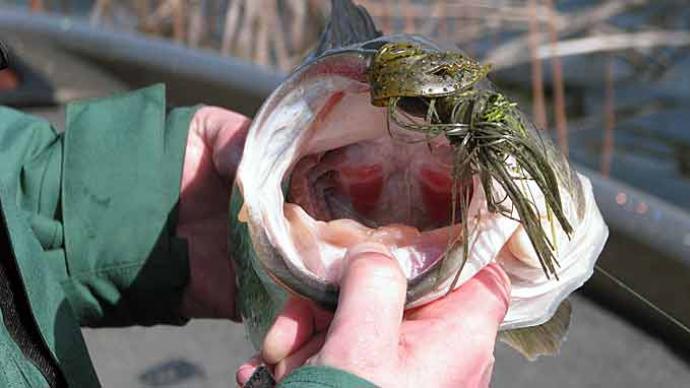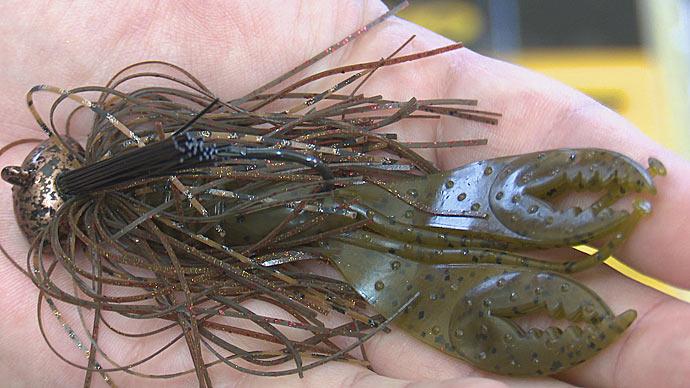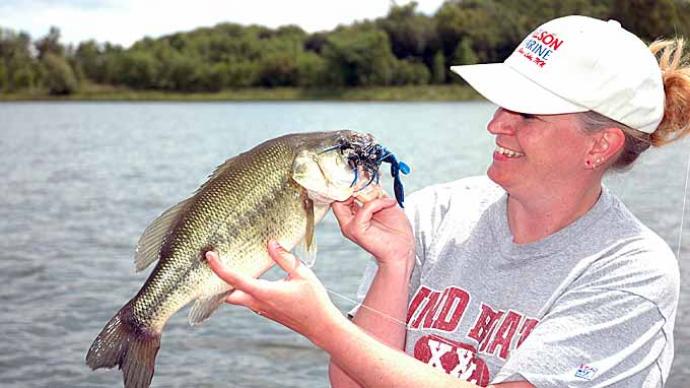
When you're talking about springtime jig tactics for bass, this is what kicks off the new bass season for many of us in the Midwest. Bass that have spent the winter months under hard water are now starting to make their way into the shallows to eat, build up energy, and then prepare for the upcoming spawn. Knowing that the bass are on the move, what are you fishing for springtime bass?
If I were limited to just one choice of lures for the spring bass bite, my choice would have to be a jig and pig combo. I would pick an Outkast RT Jig tipped with a few different plastics as a trailer to narrow it down even more.
As bass make their way into the shallows, they will make a few stops on the way before they get to their shallow destination. Point and drop-offs will be the target when they start to move. If I had to choose one, I would favor points first then drop-offs second. One of the best ways to find these areas is to have a lake map. You can do this in two ways. You can get a paper copy or use a nav chip to show you the lake right on your GPS. I prefer to use both. With a paper map, I can pre-scout areas that I think will hold bass before I even put my boat into the lake. Then with my Humminbird 997 w/GPS and my Navionics chip, I can drive right to these spots, take a quick look to see if fish are present, and start fishing. This way, I'm spending most of my fishing time on high percentage areas that should hold bass at this time of year.
When the water gets warmer, bass will start to use the shallows more, fanning out when they hit the shallows, covering more water during their day as they look for food. They will move shallower every day if the weather holds, getting to new areas. But if they are faced with cold front conditions, they will pull back to the areas coming from the points and drop-offs. The magic depth bass will hold in is 8- to 12-feet.
One key here is to look for points and drops with green weeds. Green weeds are the first cover bass will find as they move shallower. If you're fishing a lake where the weedline is shallower, the bass will be shallower, or if the weedline is located deeper, the bass will start there. The outside weedline depth will have to do with the water clarity. Weeds will grow deeper in clearer water than in dirtier water lakes.

Use these two different clarities to your advantage when springtime bass fishing. Dirty water lakes will warm faster than clearer, deeper water lakes in the spring. Use this when you start the season and when the bass in the dirty water lakes spawn. The temps in the dirty water lakes can be 3 to 5 degrees higher than a clear water lake located a few miles down the road. Bass in the dirty water lake will be active and start their springtime rituals before the bass in the clear water lake will. As the bass start to spawn in the dirty water lake, the clear water lake will just hit the drops waiting to move into the shallows. When the bass are finished spawning in the dirty water lake, the bass will start to spawn in the clear water lake. By using the two different water clarities against each other, you will have a better chance at staying on active bass throughout the early part of the springtime season.
Once you have found the areas you think are holding bass, the fun part is fishing. To cover all fishing conditions, carry all three sizes of the Outkast RT jig in your box and a few different colors. The RT jig comes in 3/8-ounce, ½-ounce, and ¾-ounce. My favorite colors are Pumpkin Chart (PC), Green Crawdad (GC), and my standard Black Blue (BB).
For trailers, I use a few different Outkast products. I'll use an Outkast Chunk (3.25). If I want or need a smaller profile, I'll use the (2.75) size chunk and team this with a 3/8-ounce jig for a smaller profile bait or again with the 3/8-ounce jig if needed faster fall the bass are aggressive and feeding. If I'm looking for a different look or doing a combination of fishing the RT Jig traditionally on the bottom or mixing in a swimming retrieve, I'll use a Fat Tail Grub as my trailer. I'll mainly use this combination in shallower water conditions when the bass move into the shallows, letting me target pinpoint areas and cover water in between.
One new combination that I have played with the last few years with great success for bigger bass has been to tip my RT Jig with an Outkast Naughty Bug. This larger profile appeals to larger bass and give the bass a new look that they have not seen before. The Naughty Bug is a bigger profile than the Chunk or the Fat Grub Tail, making the jig fall at a slower rate, staying in the strike zone longer. Also, the bigger profile of this bait seems to attract bigger bass to bite the jig. Combining these two factors seems to add to bigger bass in the spring.
So if you're looking for big springtime bass, make sure you tie on a jig. When fishing during the springtime, play with your trailer combinations to make your jig offering change its look and how the bait acts.
Please remember to practice CPR (Catch, Photo, and Release). The future of fishing is in your hands.




